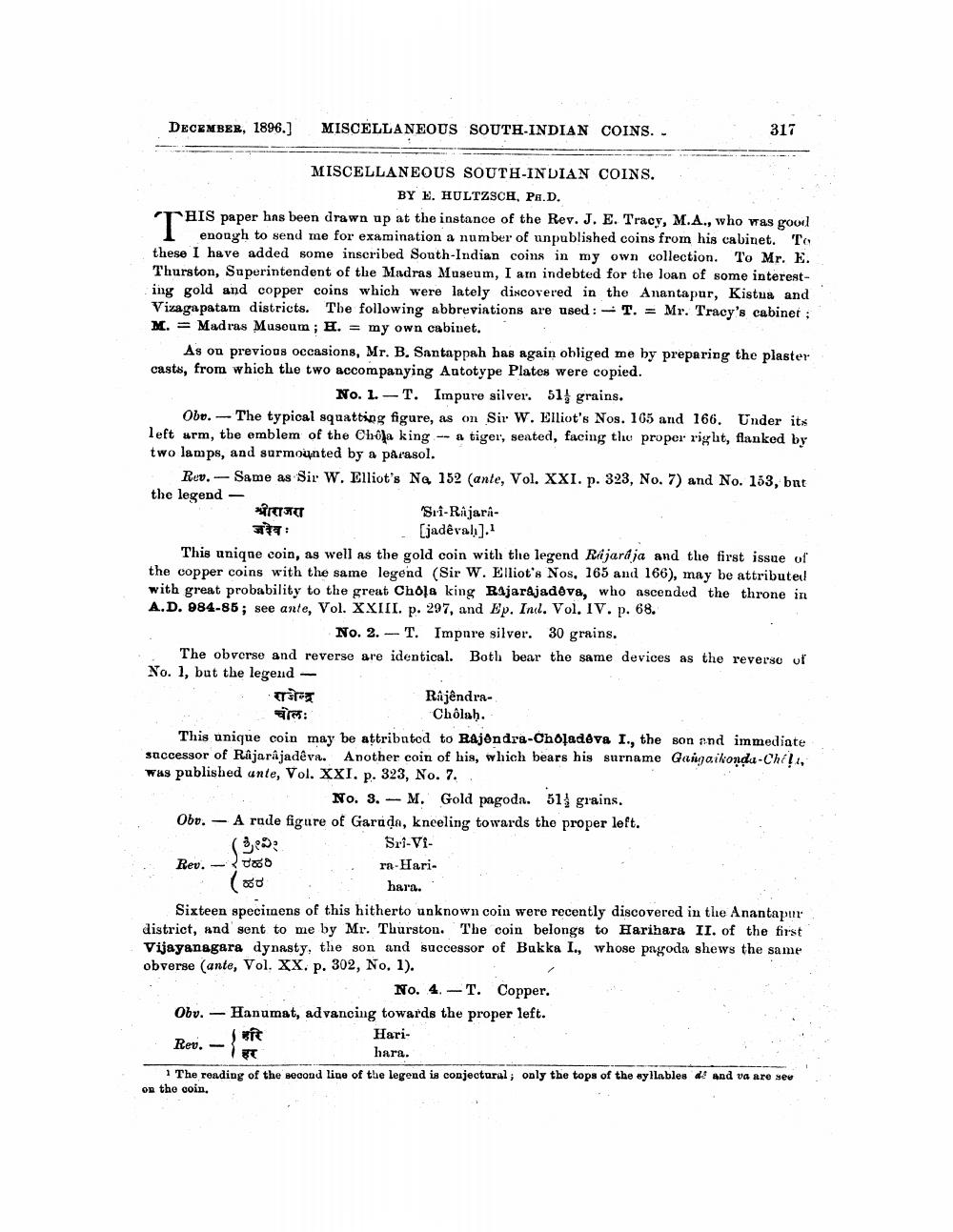________________
DECEMBER, 1896.]
MISCELLANEOUS SOUTH-INDIAN COINS. BY E. HULTZSCH, PH.D.
HIS paper has been drawn up at the instance of the Rev. J. E. Tracy, M.A., who was good
send me a number of unpublished cabinet,
these I have added some inscribed South-Indian coins in my own collection. To Mr. E. Thurston, Superintendent of the Madras Museum, I am indebted for the loan of some interesting gold and copper coins which were lately discovered in the Anantapur, Kistua and Vizagapatam districts. The following abbreviations are used:T. Mr. Tracy's cabinet; M. Madras Museum; H. = my own cabinet.
As on previous occasions, Mr. B. Santappah has again obliged me by preparing the plaster casts, from which the two accompanying Autotype Plates were copied.
MISCELLANEOUS SOUTH-INDIAN COINS..
No. 1. T. Impure silver. 51 grains.
Obe.
The typical squatting figure, as on Sir W. Elliot's Nos. 165 and 166. Under its left arm, the emblem of the Chola king- a tiger, seated, facing the proper right, flanked by two lamps, and surmounted by a parasol.
Rev. Same as Sir W. Elliot's No. 152 (ante, Vol. XXI. p. 323, No. 7) and No. 153, but the legend
श्रीराजरा जदेव :
Obv.
This unique coin, as well as the gold coin with the legend Rajaraja and the first issue of the copper coins with the same legend (Sir W. Elliot's Nos. 165 and 166), may be attributed with great probability to the great Chola king Rajarajadeva, who ascended the throne in A.D. 984-85; see ante, Vol. XXIII. p. 297, and Ep. Ind. Vol. IV. p. 68.
The obverse and reverse are No. 1, but the legend -
• राजेन्द्र चोल:
Rev.
-
317
Sri-Rajara[jadėrali],1
No. 2. T. Impure silver. 30 grains.
identical.
(000
This unique coin may be attributed to Rajendra-Choladeva I., the son and immediate successor of Rajarajadêva. Another coin of his, which bears his surname Gangaikonda-Chili, was published ante, Vol. XXI. p. 323, No. 7.
RajendraChôlah.
No. 3. -M. Gold pagoda. 51 grains. A rude figure of Garuda, kneeling towards the proper left. 3D
S
Both bear the same devices as the reverse of
Sri-Vira-Harihara.
Sixteen specimens of this hitherto unknown coin were recently discovered in the Anantapur district, and sent to me by Mr. Thurston. The coin belongs to Harihara II. of the first Vijayanagara dynasty, the son and successor of Bukka I., whose pagoda shews the same obverse (ante, Vol. XX. p. 302, No. 1).
Obv.
No. 4. T. Copper. Hanumat, advancing towards the proper left. हरि Hariहर hara.
Rev.
1 The reading of the second line of the legend is conjectural; only the tops of the syllables d and va are see on the coin.




